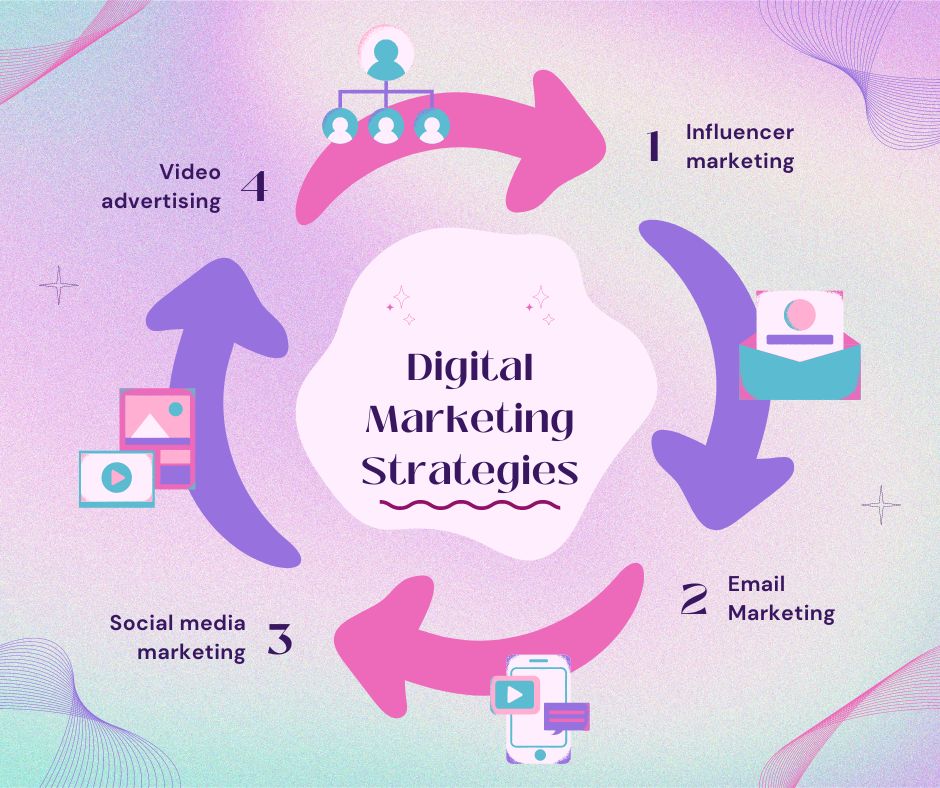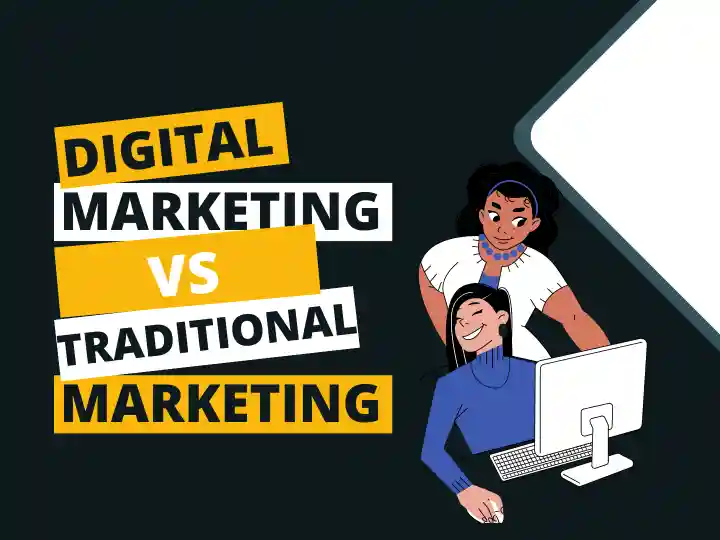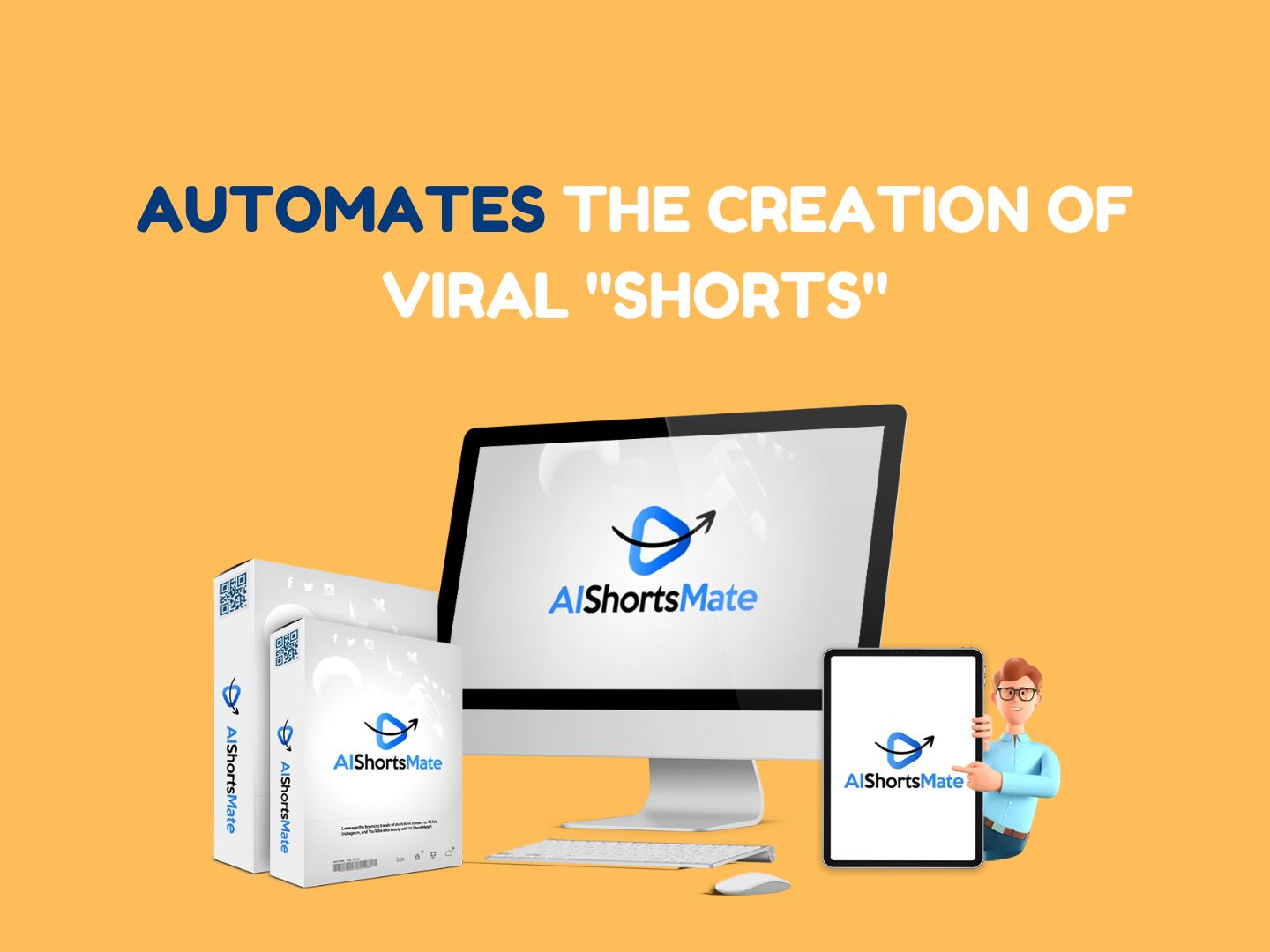Table of Contents
Traditional Marketing vs Digital Marketing
A. Definition of Traditional Marketing
Traditional marketing refers to conventional promotional strategies and tactics that have been employed by businesses for decades to reach and engage with their target audience.
These methods typically include print advertisements in newspapers and magazines, television and radio commercials, direct mail campaigns, billboards, and in-person marketing efforts such as events and trade shows.

Traditional marketing relies heavily on offline channels to distribute marketing messages and create brand awareness among consumers.
B. Definition of Digital Marketing
Digital marketing encompasses all marketing activities that utilize digital channels and technologies to connect with customers and prospects online.
This includes tactics such as search engine optimization (SEO), social media marketing, email marketing, content marketing, pay-per-click (PPC) advertising, and influencer marketing, among others.

Digital marketing leverages the internet, mobile devices, and digital platforms to deliver targeted messages, engage audiences, and drive desired actions, such as website visits, lead generation, or product purchases.
C. Importance of understanding the differences
In today’s rapidly evolving business landscape, understanding the differences between traditional marketing and digital marketing is crucial for organizations seeking to effectively allocate their marketing resources and achieve their business objectives. With consumers increasingly turning to digital channels for information, entertainment, and shopping, businesses must adapt their marketing strategies to meet changing consumer behaviours and preferences. Failing to recognize the unique characteristics and advantages of digital marketing could result in missed opportunities to reach and engage with target audiences effectively.
D. Preview of major differences to be discussed
In this discussion, we will explore the key distinctions between traditional marketing and digital marketing across several dimensions. We will examine differences in reach and audience targeting, cost-effectiveness, measurement and analytics, interaction and engagement, flexibility and adaptability, geographic targeting, tangibility and permanence, and integration and synergy. By understanding these differences, businesses can make informed decisions about their marketing strategies and leverage the strengths of both traditional and digital approaches to maximize their marketing impact and ROI.
II. Reach and Audience Targeting
A. Traditional Marketing
Traditional marketing relies on conventional channels such as television, radio, print media, and direct mail to reach audiences. These methods often have a limited reach compared to digital platforms and may not effectively target specific demographics. With traditional marketing, businesses often broadcast their message to a mass audience without precise targeting, leading to potential inefficiencies in reaching the desired customer base.
B. Digital Marketing
In contrast, digital marketing uses online channels such as search engines, social media, email, and websites to reach people. The digital landscape has a broad reach due to the widespread use of the internet and mobile devices. Furthermore, digital marketing allows for better audience targeting based on demographics, interests, behaviour, and location. This targeted approach allows businesses to tailor their messages to specific audience segments, increasing the effectiveness of their marketing efforts.
III. Cost-effectiveness
A. Traditional Marketing
Traditional marketing methods typically involve high costs associated with distribution, printing materials, and advertising space. For example, producing and distributing print ads, TV commercials, or direct mail campaigns can require significant financial investment. Additionally, advertising on traditional media channels such as television or radio often comes with a hefty price tag, making it challenging for small businesses with limited budgets to compete effectively.
B. Digital Marketing
Digital marketing offers cost-effective alternatives to traditional methods. Online platforms provide various advertising options, including pay-per-click (PPC), social media ads, and email marketing, which allow businesses to set flexible budgets based on their needs and objectives. Furthermore, digital marketing campaigns can be optimized in real-time to maximize ROI, reducing wasted ad spend and improving overall cost-effectiveness.
IV. Measurement and Analytics
A. Traditional Marketing
Traditional marketing campaigns often lack robust measurement and analytics capabilities, making it challenging for businesses to track the effectiveness of their efforts accurately. Metrics such as reach, impressions, and response rates may be difficult to quantify, leading to uncertainty about the campaign’s success. Without comprehensive data, businesses may struggle to justify their marketing expenses and make informed decisions about future strategies.
B. Digital Marketing
Digital marketing provides advanced analytics tools that offer real-time insights into campaign performance. Metrics such as website traffic, conversion rates, click-through rates, and engagement levels can be tracked accurately, allowing businesses to measure the impact of their digital marketing efforts with precision. Moreover, digital analytics platforms often provide detailed demographic and behavioural data about the audience, enabling businesses to optimize their targeting strategies and improve overall campaign effectiveness.
V. Interaction and Engagement
A. Traditional Marketing
Traditional marketing channels typically facilitate one-way communication from the business to the audience, limiting opportunities for interaction and engagement. For example, print ads, TV commercials, and billboards deliver messages without direct feedback mechanisms, making it challenging for businesses to gauge audience reactions or address customer inquiries in real time.
B. Digital Marketing
Digital marketing fosters two-way communication between businesses and their audiences, enabling greater interaction and engagement. Social media platforms, in particular, allow users to like, comment, share, and respond to marketing content, creating opportunities for meaningful interactions and building relationships with customers. Additionally, features such as live chat, feedback forms, and interactive content empower businesses to engage with audiences directly and address their needs promptly.
VI. Flexibility and Adaptability
A. Traditional Marketing
Traditional marketing campaigns often require extensive planning and lead time to execute, making them less adaptable to changing market conditions or consumer preferences. Once distributed, traditional marketing materials such as print ads or flyers are static and cannot be easily modified or updated, limiting flexibility in response to feedback or evolving trends.
B. Digital Marketing
Digital marketing offers greater flexibility and adaptability compared to traditional methods. Online campaigns can be launched quickly and modified in real time based on performance data and audience feedback. For example, digital ads can be A/B tested to determine the most effective messaging or creative elements, and campaign parameters can be adjusted on the fly to optimize results. This agility enables businesses to stay responsive to market dynamics and maintain a competitive edge in the digital landscape.
VII. Geographic Targeting
A. Traditional Marketing
Traditional marketing methods often lack precise geographic targeting capabilities, resulting in broad coverage that may not effectively reach the desired local or regional audience. For example, while local newspapers or radio stations may target specific geographic areas, the reach of these channels may still be limited, and businesses may struggle to reach potential customers outside of their immediate vicinity.
B. Digital Marketing
Digital marketing provides powerful tools for geographic targeting, allowing businesses to reach specific audiences based on location with precision. Platforms like Google Ads and social media advertising offer options to target users by geographic location, zip code, or radius around a particular area. This enables businesses to tailor their marketing messages to local markets or expand their reach to new geographic regions efficiently.
VIII. Tangibility and Permanence
A. Traditional Marketing
Traditional marketing materials such as brochures, flyers, and posters are tangible assets that customers can physically hold and interact with. However, these materials have a limited lifespan and may be discarded or forgotten once their immediate purpose is served. Additionally, traditional marketing messages conveyed through print or broadcast media may not have a lasting impact on audiences due to the transient nature of these channels.
B. Digital Marketing
Digital marketing content, while intangible, has the potential for greater permanence and longevity compared to traditional materials. For example, blog posts, social media posts, and online videos can continue to generate engagement and traffic over time, potentially reaching new audiences long after they are initially published. Additionally, digital content can be easily archived and accessed by users, providing ongoing value to both businesses and consumers.
IX. Integration and Synergy
A. Traditional Marketing
Traditional marketing channels often operate in silos, with little integration or synergy between different promotional activities. For example, a business may run separate campaigns on television, radio, and print media without coordinating messaging or branding across these channels. As a result, the overall impact of traditional marketing efforts may be diluted, and opportunities for cross-promotion or reinforcement may be missed.
B. Digital Marketing
Digital marketing offers opportunities for seamless integration and synergy across multiple channels and touchpoints. For example, businesses can leverage social media advertising to complement their email marketing campaigns or incorporate user-generated content from social platforms into their website or blog. By integrating digital marketing efforts, businesses can create cohesive brand experiences for customers across various online platforms, maximizing the impact of their marketing strategies.
Conclusion
In conclusion, understanding the key differences between traditional marketing and digital marketing is essential for developing effective marketing strategies in today’s dynamic landscape. While traditional marketing methods offer tangible benefits such as broad reach and physical presence, digital marketing presents distinct advantages in terms of audience targeting, cost-effectiveness, measurability, and flexibility. By leveraging the strengths of both approaches and embracing a hybrid marketing strategy, businesses can maximize their reach, engagement, and ROI in an increasingly digital world.




